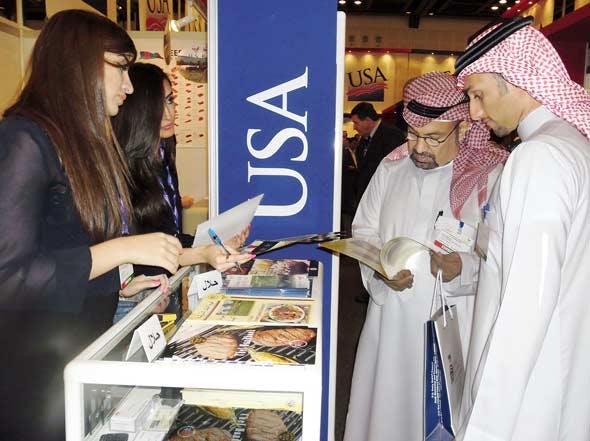U.S. Beef Draws Tremendous Interest at Gulfood 2012
Published: Feb 28, 2012

Coming off a record-smashing year for beef exports in the rapidly growing Middle East region, it’s no surprise that U.S. suppliers turned out in record numbers for Gulfood 2012. One of the world’s largest food industry trade shows, Gulfood was held Feb. 19-22 in Dubai, United Arab Emirates (UAE), with more than 3,800 companies exhibiting products and services and total attendance over four days exceeding 60,000. USMEF’s participation was supported by the Beef Checkoff Program and the USDA Market Access Program (MAP).
“Beef demand in the region remains buoyant and shows little effect from the political disturbances in some Middle Eastern countries, the financial concerns of the European Union or the build-up in tension over Iran’s nuclear program,” said John Brook, USMEF regional director for Europe, Russia and the Middle East. “U.S. beef is well-established in the Middle East but has traditionally been in second place behind Australia at the upper end of the market. However, several U.S. companies reported booking orders that clearly indicate some displacement of Australian product.”
“As a first time attendee at Gulfood, it was a wonderful opportunity to gain valuable knowledge of the potential for beef exports in that region,” added Mark Boyd, who directs export sales for Protimex/Porky Products. “I look forward to expanding our business there.”
“Beef demand in the region remains buoyant and shows little effect from the political disturbances in some Middle Eastern countries, the financial concerns of the European Union or the build-up in tension over Iran’s nuclear program,” said John Brook, USMEF regional director for Europe, Russia and the Middle East. “U.S. beef is well-established in the Middle East but has traditionally been in second place behind Australia at the upper end of the market. However, several U.S. companies reported booking orders that clearly indicate some displacement of Australian product.”
“As a first time attendee at Gulfood, it was a wonderful opportunity to gain valuable knowledge of the potential for beef exports in that region,” added Mark Boyd, who directs export sales for Protimex/Porky Products. “I look forward to expanding our business there.”

With an ever-increasing number of restaurants and modern retail outlets opening throughout the Middle East, the need for imported beef - particularly quality beef muscle cuts - continues to rise. USMEF has worked aggressively to capitalize on these opportunities, conducting retail education campaigns that emphasize sales training and help familiarize supermarket and meat department managers with a wide variety of versatile U.S. beef cuts. USMEF foodservice promotions also play a key role in the expansion of U.S. beef in the Middle East, especially as diners show an increasing appetite for higher-quality entrées.
While Egypt ($236 million in 2011) is the region’s mainstay market for U.S. beef, excellent growth continues in several other countries. The UAE was last year’s second-largest Middle Eastern market for U.S. beef, posting 28 percent growth in volume (8,146 metric tons, or 18 million pounds) and a 40 percent increase in value ($38.8 million). Prospects brightened for even stronger growth in the UAE this year, as cattle age and product restrictions on U.S. beef were recently lifted.

Exports to Saudi Arabia increased 6 percent in volume (6,628 metric tons, or 14.6 million pounds) but also achieved a 40 percent increase in value to $31.6 million. Region-wide, U.S. beef exports expanded 30 percent in volume to 175,181 metric tons ($386.2 million pounds) and 36 percent in value to $355.9 million. Emerging markets such as Kuwait ($19.4 million, up 57 percent), Qatar ($10.4 million, up 74 percent), Jordan ($6.2 million, up 74 percent), Bahrain ($4.9 million, up 6 percent) and Oman ($4.3 million, nearly 400 times the previous year’s total) all posted solid growth and placed among the top 50 value destinations for U.S. beef.
According to Brook, Gulfood buyers also showed an increased interest in U.S. lamb this year. Though still fairly small, U.S. lamb exports to the Middle East grew 58 percent in volume in 2011 (205 metric tons or about 452,000 pounds) and more than doubled in value to $672,000. The UAE was the largest volume market, but Jordan accounted for more than 40 percent of the value.
“We have some challenges in terms of product specifications and portion size, but I found the exchanges with lamb buyers rather encouraging,” Brook said.
